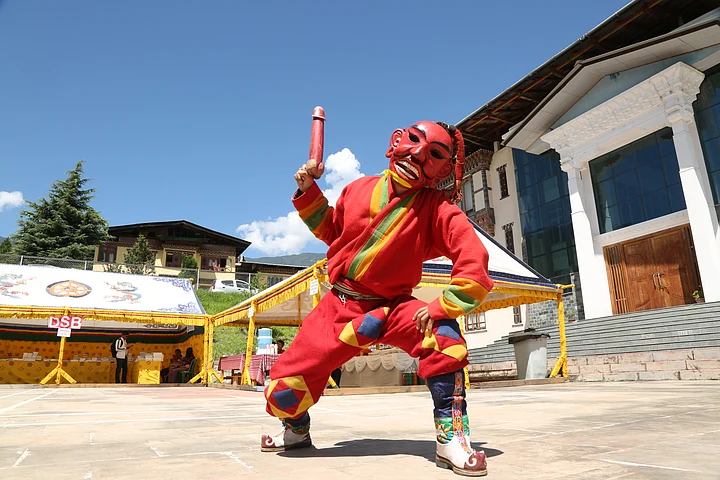“The mask is a helmet”, says one of the few actors/dancers who play Atsara (Acharya) as he walks around teasing young girls, breaking into dance and scandalising the school students.
Atsara is a popular folk figure from the Himalayan nation of Bhutan, which started as a Buddhist sanctuary and later became a self-isolated kingdom that opened its doors to the rest of the world only in 1960. Before that they neither had formal roads, nor did they even have a postal system.
Atsara is the transcendental fool - an accomplished scholar who, in a state of trance, can break free and do whatever pleases him.
“The atsaras feel no embarrassment, they have learnt the samsaric truth”, says the unnamed youth who took off the mask after much insistence, but refused to reveal his name.
The phallus, found commonly on top of doors and in tourist shops, is not a fertility symbol. Just like Thor’s hammer, this accessory is his superhero-esque power-stick that makes him impenetrable to embarrassment. People don’t think of these atsaras as a joke, but as a messenger of holy messages.
It’s common for these atsaras to have led an ascetic life of a monk; they guard their identity, only to keep the mysticism alive, for when they don the mask, they are the embodiment of the learned scholar. If only other scholars were this fun!
Wearing brocade jackets, carrying traditional Bhutanese instruments and with their faces hidden behind wooden and papier mache masks, the masked dancers are a regular fixture in the traditional festivals of Bhutan known as Tsechus.
The Mountain Echoes Lit Fest 2016, that celebrates books and Bhutanese culture, too was opened by a performance by a handful of dancers from the Royal Academy of Performing Arts, whose patron is the royal family itself.
We asked the dancers, many of whom had been to India to perform as well as to study, what they thought of the country that, though culturally and politically very different, has had close ties with the mountain kingdom, the only monarchy in the Indian sub-continent.
These dances are performed for multiple reasons. Some dances push morality, some dances protect the humans from evil spirits around them, and some to revel in victories. The ‘garuda’, an important mythological creature in Buddhist and Indian mythology, represents the king of birds.
Sangay, who plays ‘garuda’, has never been to India and his connection to India has been through Bollywood. Even before there was cable in Bhutan, many in Bhutan would watch television series and movies recorded on VCR tapes, smuggled in through the border. Sangay was one of them.
“I don’t know”, says Sangam Chhogiyal who dons the mask of the Senggeh, the snow lion, before he goes on to ask that though he likes Indian food is very tasty but “why do you put turmeric in everything?”
“I have heard most of the people in India are very poor and they don’t even get to eat. We don’t have this problem”, says Sonam T who too belongs to the Royal Academy of Performing Arts, which is the main guardian of Bhutanese folk art.
“We are the faces of the saints and the sages. The moment when I am dancing, I become holy and divine for even the people around me”, says C Wangmo who plays Druelgo or the serpent-headed helper who holds a mirror to reflect the deeds of the deceased during his life.
As for the phallic symbol - the writing’s on the wall - it can be spotted on the walls of houses in Thimpu trying to avoid bad luck. But due to recent urbanisation of the region, more and more people are moving away from putting the dong on their doors.
(At The Quint, we question everything. Play an active role in shaping our journalism by becoming a member today.)
